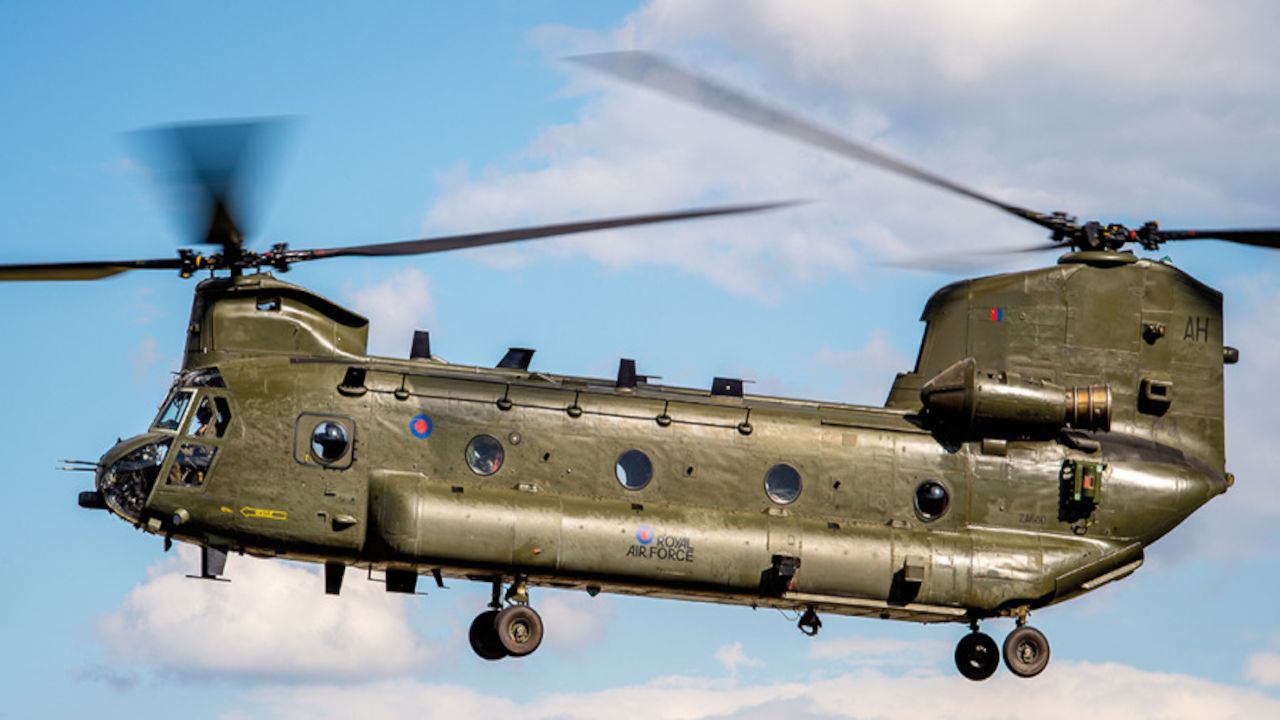On 22 November 1980, the first Chinook was delivered to the Royal Air Force (RAF). 40 years later, this iconic twin-engined, tandem rotor, heavy-lift helicopter continues to play an unmatched and unique role in defence missions at home and abroad.
Flown by the RAF and tasked by Joint Helicopter Command, the Chinook Force has deployed around the world, including the Falklands, the Balkans, Northern Ireland, Iraq, Afghanistan and more recently supporting French forces in Mali with logistics and moving troops.
At home, the Chinook is called upon for humanitarian missions. Chinooks were used in the UK government’s Covid-19 response and to support the efforts to save the town of Whaley Bridge from flooding in 2019.
More than 450 people are employed across the UK to maintain and upgrade the RAF’s fleet of 60 helicopters.
How it began
Aviation pioneer Frank Piasecki built the world’s first tandem rotor helicopter, the precursor to the Boeing Chinook we know today.
Born in 1919, Piasecki grew up with a fascination for aviation and the technology behind it. After studying aeronautical engineering at university, he founded the P-V engineering Forum and designed the PV-2 helicopter.
By 1945, he was contracted to design a large, tandem rotor helicopter for the U.S. Navy, who wanted it to carry heavy loads. It was fondly called the ‘Flying Banana.’
Boeing acquired the Piasecki Helicopter Corporation in 1960.
Frank’s daughter, Nicole Piasecki, worked for Boeing and opened the Boeing office named ‘Piasecki House’, in Yeovil, Somerset in 2016 after she retired.
Chinook in the UK
1970s
-
1978 - The Ministry of Defence orders the Chinook for the RAF.
1980s
-
November 1980 - The first RAF Chinook arrives in the UK.
-
April 1982 - Four Chinooks deploy to the Falklands Islands. Three are lost onboard the MV Atlantic Conveyor after it was hit by an Argentine Exocet missile and Bravo November is the only surviving aircraft to return to the UK.
-
1984-1986 - Eight more Mk1s are delivered to the RAF with upgrades to engines and cockpits.
1990s
-
January 1991 - The Chinook becomes a vital transit tool during the Gulf War.
-
1993-1999 - The Mk2 comes into service and sees extensive service in the Balkans, Iraq and Afghanistan.
-
June 1999 - The Chinook transports troops to join NATO forces serving in the Balkans.
2000s
-
Early 2000s - The Mk3 comes into service intended for a variety of specialist operations.
-
March 2002 - Chinooks based in northern Afghanistan undertake humanitarian relief flights, following an earthquake.
-
May 2002 - Chinooks carry out first British troop ;INSERT INTOion at Forward Operating Bases in Afghanistan and undertakes continuous deployment on Op HERRICK until 2014.
-
October 2005 - When an earthquake hits Pakistan, Chinooks are deployed for a bespoke disaster relief operation.
-
May 2006 - A 34-year agreement for Through Life Customer Support (TLCS) is signed between Boeing and the RAF.
-
December 2008 - The fleet begin Project Julius, a glass cockpit upgrade to bring them up to Mk4 and Mk5.
2010s
-
December 2015 - RAF takes final delivery of 14 Mk6 with the Boeing DAFCS, which revolutionises the Chinook capability and takes the fleet to 60.
-
March 2016 - The Boeing site in Yeovil, Somerset, is named Piasecki House, after the innovator of the Chinook design.
-
August 2019 - Chinook Force is called upon to join the efforts to save the town of Whaley Bridge from flooding.
2020 - future
-
March 2020 - Chinook is tasked with moving people and supplies across the UK in support of the fight against Covid-19.
-
April 2020 - Chinook is recognised for its work at Whaley Bridge by the Vertical Flight Society.
-
November 2020 - Boeing and Royal Air Force partnership marks 40 Years of Chinook flying in the UK.
-
Early 2021 - The DAFCS upgrade, the most in-depth and complex aviation modification performed to date by Boeing colleagues in the UK on the RAF’s Chinook Force, is due to complete.



